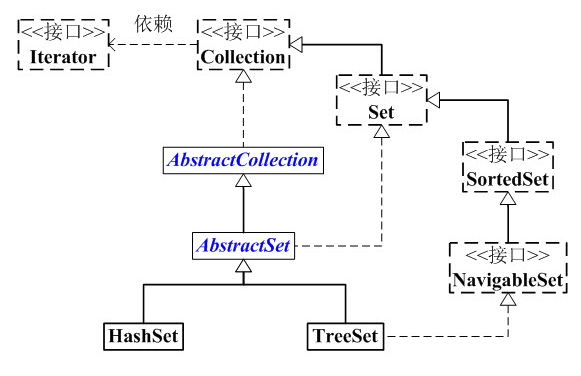概述
Set也是继承自Collection,Set也是集合的一种,同时Set不允许重复的元素存在。Set的实现类都是基于Map来实现的,其中HashSet是通过HashMap来实现的,TreeSet是通过TreeMap实现的。
Set架构:

(1)Set是继承于Collection的接口,它是一个不允许重复元素的集合。
(2)AbstractSet是一个抽象类,继承了AbstractCollection,AbstractCollection实现了Set中的绝大部分函数,为Set的实现类提供了便利。
(3)HashSet和TreeSet是Set的两个实现类。HashSet依赖于HashMap,实际上是通过HashMap来实现的,HashSet中的元素是无序的。TreeSet依赖于TreeMap,实际上是通过TreeMap实现的,TreeSet中的元素是有序的。
基于Java8的AbstractCollection源码:
public abstract class AbstractCollection<E> implements Collection<E> {
protected AbstractCollection() {//构造函数
}
public abstract Iterator<E> iterator();//迭代器
public abstract int size();//集合大小
public boolean isEmpty() {//集合是否为空
return size() == 0;
}
public boolean contains(Object o) {//判断是否包含某个元素,通过迭代遍历的方式
Iterator<E> it = iterator();
if (o==null) {
while (it.hasNext())
if (it.next()==null)
return true;
} else {
while (it.hasNext())
if (o.equals(it.next()))
return true;
}
return false;
}
public Object[] toArray() {//生成数组
// Estimate size of array; be prepared to see more or fewer elements
Object[] r = new Object[size()];
Iterator<E> it = iterator();
for (int i = 0; i < r.length; i++) {
if (! it.hasNext()) // fewer elements than expected
return Arrays.copyOf(r, i);
r[i] = it.next();
}
return it.hasNext() ? finishToArray(r, it) : r;
}
@SuppressWarnings("unchecked")
public <T> T[] toArray(T[] a) {//泛型方式生成数组
// Estimate size of array; be prepared to see more or fewer elements
int size = size();
T[] r = a.length >= size ? a :
(T[])java.lang.reflect.Array
.newInstance(a.getClass().getComponentType(), size);
Iterator<E> it = iterator();
for (int i = 0; i < r.length; i++) {
if (! it.hasNext()) { // fewer elements than expected
if (a == r) {
r[i] = null; // null-terminate
} else if (a.length < i) {
return Arrays.copyOf(r, i);
} else {
System.arraycopy(r, 0, a, 0, i);
if (a.length > i) {
a[i] = null;
}
}
return a;
}
r[i] = (T)it.next();
}
// more elements than expected
return it.hasNext() ? finishToArray(r, it) : r;
}
private static final int MAX_ARRAY_SIZE = Integer.MAX_VALUE - 8;
@SuppressWarnings("unchecked")
private static <T> T[] finishToArray(T[] r, Iterator<?> it) {
int i = r.length;
while (it.hasNext()) {
int cap = r.length;
if (i == cap) {
int newCap = cap + (cap >> 1) + 1;
// overflow-conscious code
if (newCap - MAX_ARRAY_SIZE > 0)
newCap = hugeCapacity(cap + 1);
r = Arrays.copyOf(r, newCap);
}
r[i++] = (T)it.next();
}
// trim if overallocated
return (i == r.length) ? r : Arrays.copyOf(r, i);
}
//对输入的minCapacity判断最大容量
private static int hugeCapacity(int minCapacity) {
if (minCapacity < 0) // overflow
throw new OutOfMemoryError
("Required array size too large");
return (minCapacity > MAX_ARRAY_SIZE) ?
Integer.MAX_VALUE :
MAX_ARRAY_SIZE;
}
//添加对象
public boolean add(E e) {
throw new UnsupportedOperationException();
}
//通过迭代查找,删除对象
public boolean remove(Object o) {
Iterator<E> it = iterator();
if (o==null) {
while (it.hasNext()) {
if (it.next()==null) {
it.remove();
return true;
}
}
} else {
while (it.hasNext()) {
if (o.equals(it.next())) {
it.remove();
return true;
}
}
}
return false;
}
//判断集合C中的元素是否都存在
public boolean containsAll(Collection<?> c) {
for (Object e : c)
if (!contains(e))
return false;
return true;
}
//将集合c中的元素添加
public boolean addAll(Collection<? extends E> c) {
boolean modified = false;
for (E e : c)
if (add(e))
modified = true;
return modified;
}
//删除掉集合c中在此集合中的元素
public boolean removeAll(Collection<?> c) {
Objects.requireNonNull(c);
boolean modified = false;
Iterator<?> it = iterator();
while (it.hasNext()) {
if (c.contains(it.next())) {
it.remove();
modified = true;
}
}
return modified;
}
//删除掉此集合中在c中不存在的对象
public boolean retainAll(Collection<?> c) {
Objects.requireNonNull(c);
boolean modified = false;
Iterator<E> it = iterator();
while (it.hasNext()) {
if (!c.contains(it.next())) {
it.remove();
modified = true;
}
}
return modified;
}
//清空集合
public void clear() {
Iterator<E> it = iterator();
while (it.hasNext()) {
it.next();
it.remove();
}
}
//通过StringBuilder生成string
public String toString() {
Iterator<E> it = iterator();
if (! it.hasNext())
return "[]";
StringBuilder sb = new StringBuilder();
sb.append('[');
for (;;) {
E e = it.next();
sb.append(e == this ? "(this Collection)" : e);
if (! it.hasNext())
return sb.append(']').toString();
sb.append(',').append(' ');
}
}
}
基于Java8的AbstractSet源代码:
public abstract class AbstractSet<E> extends AbstractCollection<E> implements Set<E> {
protected AbstractSet() {
}
public boolean equals(Object o) {//判断两个集合是否相同
if (o == this)
return true;
if (!(o instanceof Set))
return false;
Collection<?> c = (Collection<?>) o;
if (c.size() != size())
return false;
try {
return containsAll(c);
} catch (ClassCastException unused) {
return false;
} catch (NullPointerException unused) {
return false;
}
}
//计算hashCode
public int hashCode() {
int h = 0;
Iterator<E> i = iterator();
while (i.hasNext()) {
E obj = i.next();
if (obj != null)
h += obj.hashCode();
}
return h;
}
//删除此集合中与c中相同的对象
public boolean removeAll(Collection<?> c) {
Objects.requireNonNull(c);
boolean modified = false;
if (size() > c.size()) {
for (Iterator<?> i = c.iterator(); i.hasNext(); )
modified |= remove(i.next());
} else {
for (Iterator<?> i = iterator(); i.hasNext(); ) {
if (c.contains(i.next())) {
i.remove();
modified = true;
}
}
}
return modified;
}
}
基于Java8的SortSet源码:
public interface SortedSet<E> extends Set<E> {基于Java8的NavigableSet源码:
Comparator<? super E> comparator();
SortedSet<E> subSet(E fromElement, E toElement);
SortedSet<E> headSet(E toElement);
SortedSet<E> tailSet(E fromElement);
E first();
E last();
@Override
default Spliterator<E> spliterator() {
return new Spliterators.IteratorSpliterator<E>(
this, Spliterator.DISTINCT | Spliterator.SORTED | Spliterator.ORDERED) {
@Override
public Comparator<? super E> getComparator() {
return SortedSet.this.comparator();
}
};
}
}
public interface NavigableSet<E> extends SortedSet<E> {
E lower(E e);
E floor(E e);
E ceiling(E e);
E higher(E e);
E pollFirst();
E pollLast();
Iterator<E> iterator();
NavigableSet<E> descendingSet();
Iterator<E> descendingIterator();
NavigableSet<E> subSet(E fromElement, boolean fromInclusive,
E toElement, boolean toInclusive);
NavigableSet<E> headSet(E toElement, boolean inclusive);
NavigableSet<E> tailSet(E fromElement, boolean inclusive);
SortedSet<E> subSet(E fromElement, E toElement);
SortedSet<E> headSet(E toElement);
SortedSet<E> tailSet(E fromElement);
}
基于Java8的Set源码:
public interface Set<E> extends Collection<E> {
int size(); //大小
boolean isEmpty();//是否为空
boolean contains(Object o); //是否包含某个对象
Iterator<E> iterator(); //生成迭代器
Object[] toArray(); //返回Object数组
<T> T[] toArray(T[] a); //返回泛型数组
boolean add(E e); //向set中添加元素
boolean remove(Object o); //从set中删除某个元素
boolean containsAll(Collection<?> c); //某个Collection是否都包含在此lset中
boolean addAll(Collection<? extends E> c); //将某个Collection追加到此set中
boolean retainAll(Collection<?> c); //删除不存在于Collection中的set中的元素
boolean removeAll(Collection<?> c); //删除包含在此Collection中的元素
void clear(); //清空set
boolean equals(Object o);//判断两个set是否相同
int hashCode(); //计算set的hashCode
@Override
default Spliterator<E> spliterator() {
return Spliterators.spliterator(this, Spliterator.DISTINCT);
}
}最后
以上就是朴实灯泡为你收集整理的Java集合之Set的全部内容,希望文章能够帮你解决Java集合之Set所遇到的程序开发问题。
如果觉得靠谱客网站的内容还不错,欢迎将靠谱客网站推荐给程序员好友。
本图文内容来源于网友提供,作为学习参考使用,或来自网络收集整理,版权属于原作者所有。








发表评论 取消回复